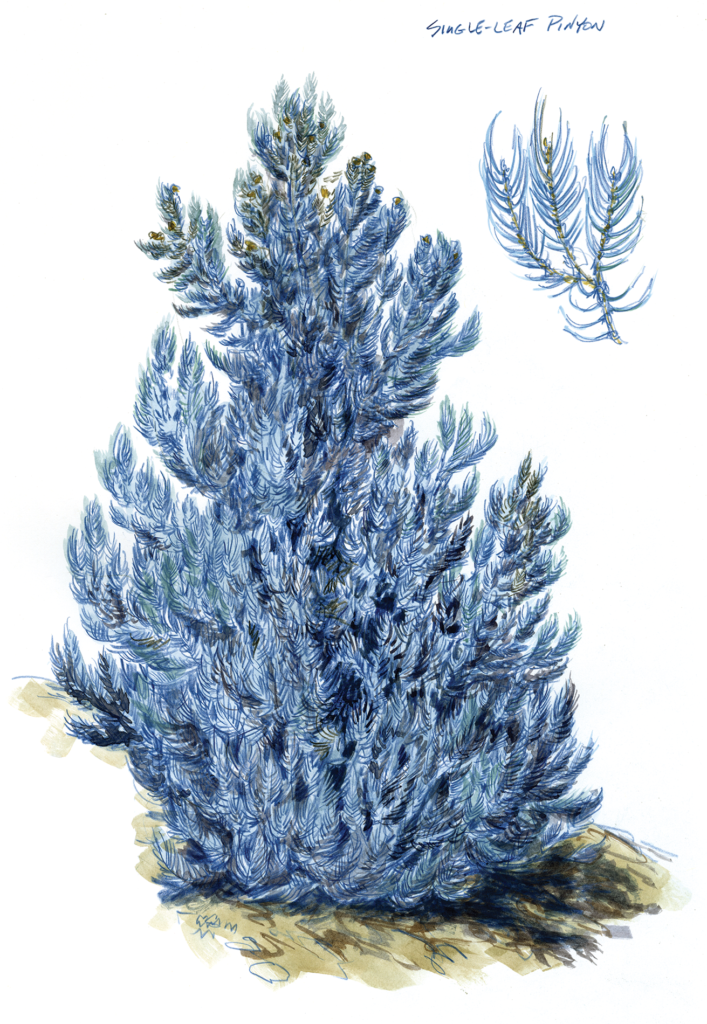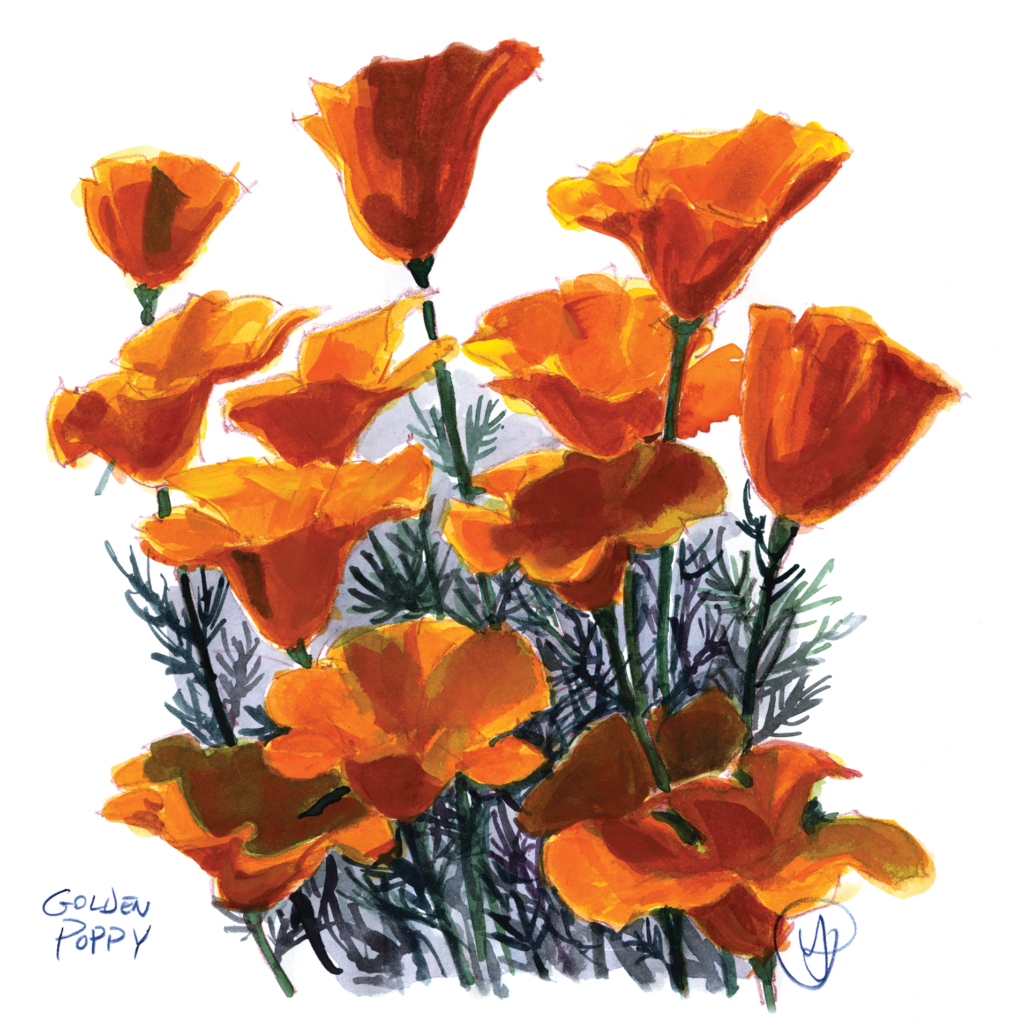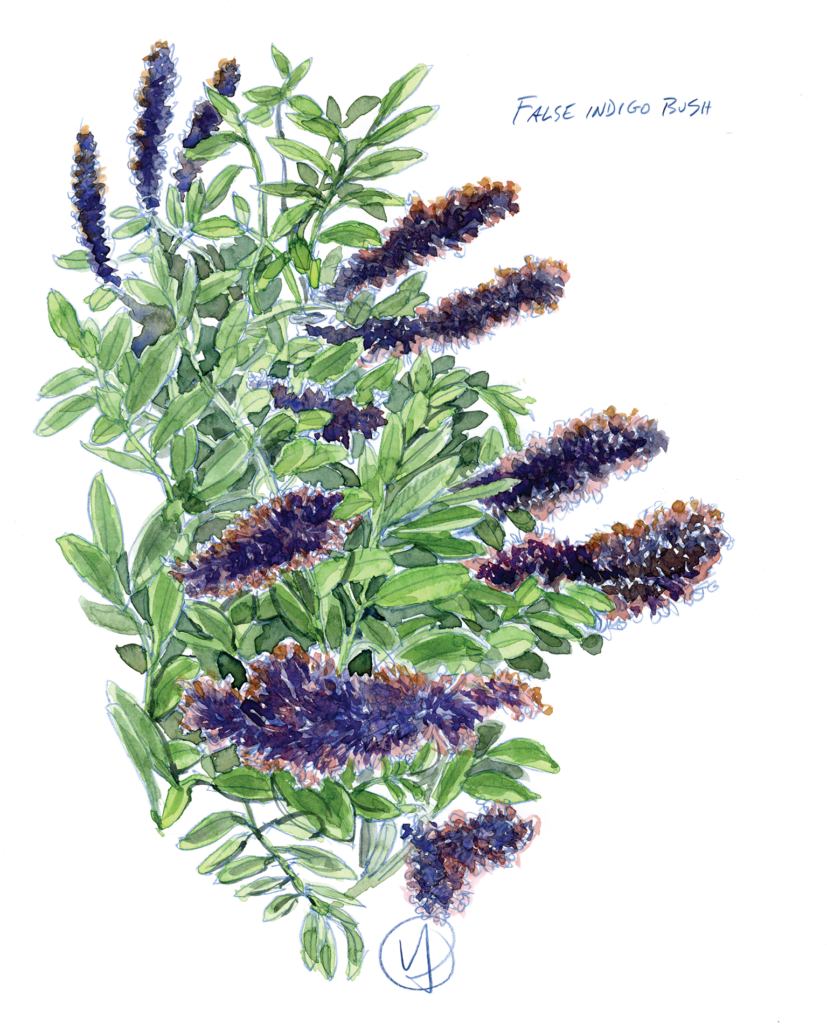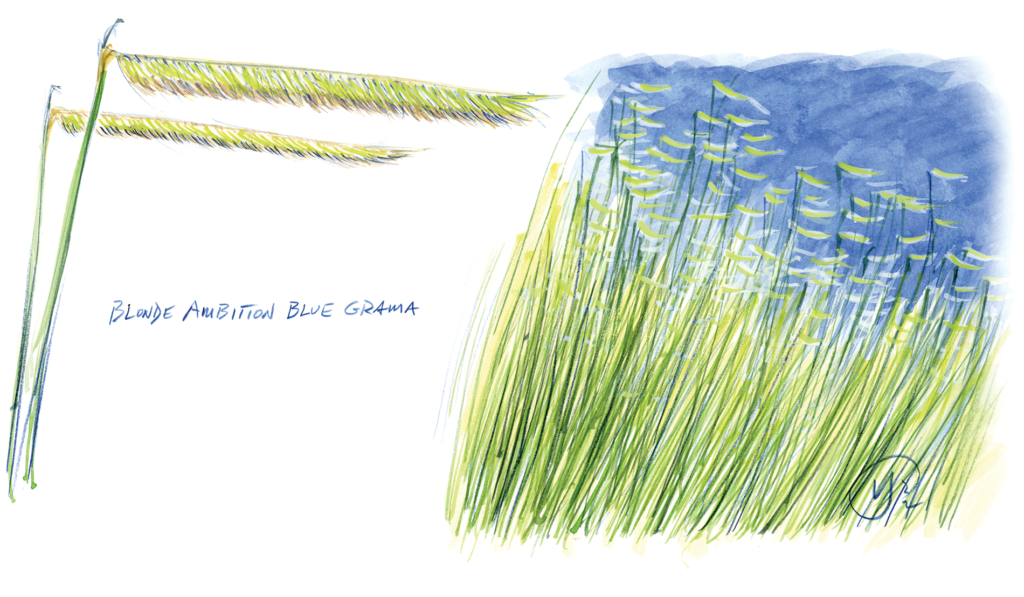The term water-wise landscaping often evokes images of spartan yards with gray boulders and unhospitable views. But strolling through the Red Butte Water Conservation Garden on the U’s campus, the lush foliage, verdant bushes, and blooming flowers challenge that assumption. “Planting for our climate doesn’t mean we have to make our yards a depressing landscape of rocks,” says Derrek Hanson BS’99 MPA’07, Red Butte Garden’s new executive director. “Whatever type of plant you like, there are water-wise alternatives.”
As Utah enters another summer likely to be plagued by drought, there are opportunities to make a difference by changing how we view our water resources and how we use them wisely to create beautiful, locally adapted landscapes, says Guy Banner, a horticulturalist at Red Butte Garden and a water-wise gardening expert. Approximately 65 percent of Utah’s annual culinary water consumption is applied to landscapes, according to Utah State University’s Center for Water Efficient Landscaping. Much of Utah, and the west, is high elevation desert—and that’s not going to change. “Our population is growing, and our water supply is not,” Hanson says. “We owe it to our community to figure out a way to balance the lack of water with our landscapes.”
And while thousands of people wander the paths of Red Butte Garden each year, we want to bring some of their gardens—and water-wise wisdom—to you. Here are just a few techniques, plants, and classes to help you get started putting in roots for a more sustainable future.
Meet Some Water-Wise Plants
Florae perfectly acclimated to the arid valleys of Utah and the surrounding area
Click plant image to enlarge.
 TREES
TREES
Single-leaf pinyon (Pinus monophylla)
The gray hues of this thick evergreen tree blend beautifully with desert landscapes. It can grow to be 10 feet wide and up to 30 feet tall. It will need little to no fertilizer and watering just once or twice
a month.
Other options: Kentucky Coffeetree (Gymnocladus dioicus ‘Espresso’), Rocky Mountain juniper (Juniperus scopulorum), Arizona cypress (Cupressus arizonica), Gambel oak, giant white yucca (Yucca faxoniana), Texas live oak, jujube, Joshua tree, desert willow (Chilopsis linearis), white mulberry (we suggest the white-fruited varieties to avoid stains from bird droppings)
 GROUND COVERS
GROUND COVERS
Woolly thyme (Thymus lanuginosus)
Some plants just make you want to feel them, and that’s the case with this herb. Grow this tough perennial with pinkish-purple flowers between the cracks of paving stones, along a gravel path, or to replace other turf such as that formed by grass. This herb doesn’t mind being trod on—in fact, it produces a citrusy bouquet when pressed.
Other options: Sedums, bearberry (Arctostaphylos uva-ursi), thyme leaf speedwell (Veronica oltensis), blue woolly speedwell (Veronica pectinate), alpine cinquefoil (Potentilla neumanniana ‘Nana’), creeping goldenaster (Hetereotheca jonesii), silver nailwort (Paronychia Kepela ssp. Serpyllifolia)
 PERENNIALS/ANNUALS
PERENNIALS/ANNUALS
California (golden) poppy (Eschscholzia californica)
Its cheerful blooms spring up nearly overnight, swathing wide plots with bright, silky petals and blue-green foliage.
Other options
Annuals: Rocky Mountain bee plant (Cleome serrulata), Arroyo lupine (Lupinus succulentus), desert bluebells (Phacelia campanularia)
Perennials: Wasatch penstemon (Penstemon cyananthus), chocolate flower (Berlandiera lyrata), Little Mountain beebalm (Monardella odoratissima), desert globemallow (Sphaeralcea ambigua), Eastern Mohave buckwheat (Eriogonum fasciculatum var. polifolium), fire chalice (Epilobium canum var. garettii), cushion buckwheat (Eriogonum ovalifolium), Utah sweetvetch (Hedysarum boreale), and many more
 VINES
VINES
Western virgin’s bower (Clematis ligusticifolia)
Drought-tolerant, this vine will encase chain-link fences and clamber over trees. The delicate white flowers appear in late summer and are followed by silky seed heads. It can grow up to 60 feet long and thrives throughout the western United States.
Other options: Coral honeysuckle (Lonicera sempervirens), Kintzley’s Ghost honeysuckle (Lonicera reticulata), Arizona grape (Vitis arizonica), California grape (Vitis californica), trumpet vine (Campsis radicans)
 SHRUBS
SHRUBS
False indigo bush (Amorpha fruticosa)
Shrubs are a terrific way of landscaping areas that are more difficult to access; they can shade out weeds, provide habitat for birds and pollinators, and give bright colors when they blossom. The bloom on this airy plant lasts only two or three weeks each spring, but the purple flowers add a lovely point of interest.
Other options: Fernbush (Chamaebatiaria millefolium), golden currant (Ribes aureum), manzanita, leadplant, Wyoming big sagebrush, blue sage (Salvia pachyphylla), Oregon grape, Tiger Eyes cutleaf staghorn sumac
 GRASSES
GRASSES
Blonde Ambition blue grama (Bouteloua gracilis)
Flag-like golden flowerheads emerge from the blue-green foliage in the middle of summer and provide many months of interest as they hang on through the winter. This grass is cold-hardy and grows well in most types of soil.
Other options: Big bluestem grass (Andropogon gerardii), Great Basin wildrye (Leymus cinereus), sand dropseed (Sporobolus cryptandrus), Karl Foerster feather reed grass, little bluestem, deer grass, pink muhly grass, alkali sacaton and varieties
TECHNIQUES YOU SHOULD KNOW
Gravel and Rock Gardening
Placing a deep layer of gravel over the ground helps prevent weeds, insulate soil and roots from hot and cold temperatures, retain moisture, and protect from erosion. It also improves drainage and reduces the risk of root rot.
With rock gardening, the crevices between stones, the shady and sunny sides of boulders, and other sheltered spaces can act as thermal banks and help modify temperature extremes so a variety of plants can thrive. Try building mounds of half-buried stones of varying sizes and prepare well-draining soil to create microclimates in your landscape.
Hydrozoning
Grouping plants with similar water needs is known as hydrozoning. There are four irrigation zones to consider once your plantings have gone through an establishment period of regular watering. Focus on watering deeply and less often to encourage deep roots for more drought-proof plants.
- Routine: This includes thirsty turfgrass like Kentucky bluegrass, water-loving shrubs and flowers, small fruits, and vegetables. These likely need watering twice a week or more.
- Reduced: Think of things like your established, average- to low-water perennials and fruit trees. They need to be watered about once a week.
- Limited: These are hardy plants that need limited watering or only need attention during extreme dry spells, including many ground covers, perennials, tough shrubs, and drought-tolerant grasses.
- Nonirrigated: Some mulched areas, xeric vegetation, and native plants will require no irrigation or watering.
Refine Your Design
Create a map of your yard, draw bubbles around the different features in your landscape, and label each with an irrigation zone. Now, focus on building up the limited and nonirrigated zones and reducing the routine zones. For example, if much of your backyard is covered in turfgrass, consider replacing portions with a rock garden highlighted with native plants that will serve as a limited irrigation zone.
TIPS FOR BEGINNERS
Consider the big picture. Get an overall view of your yard and what affects it. How much light does it get? Is there a shaded north-facing slope where many sun-loving plants wouldn’t flower?
Observe the temperature. Cold winter air and moisture may settle in parts of your yard and be a challenge for some desert plants. Consider heat-loving plants for sunny western and southern exposures.
Identify existing irrigation and precipitation effects. Where does water collect and drain? Look for dry and wet areas and incorporate these into your hydrozoning. Areas that stay wet in winter can cause many low water plants to suffer.
Plan for natural turf. Identify where it makes the most sense to keep—children’s play areas, pet areas, and areas of a size and shape that are easy to maintain efficiently.
Create varying points of interest. Consider when plants bloom throughout the growing season for a consistent display and features that provide focus in different seasons, like fall color and attractive winter bark.
Do an at-home soil test. Dig about 12 inches down into your yard and place that dirt in a jar. Mix it with water and shake. Set it out overnight to see how it settles as the finest, sandy layers rise to the top and the more clay-like earth remains on the bottom. This can give an idea of the makeup and texture of your soil.
If your soil is primarily clay, it will retain water, and you may need to improve drainage with lots of sharp sand or fine gravel and some compost or mulch. A sandier mix of soil is a good fit for most desert plants.
Take baby steps. Not everyone has the time or resources to convert a large yard in a single season. Consider starting with things like parking strips and make long-term goals and plans for other areas.
Decide what you want from your space. Consider things like vegetables, fruits, flowers, pollinators, sun, shade, formal design, topiary, and meadows.
Consider what you are keeping and remove unwanted plants and weeds before you start. Then plan your hydrozones.
Add circles for light, temperature, wind, privacy, water flow, and other features.
Plan an irrigation schedule with less frequent deep watering that encourages roots to grow deeper in pursuit of the H2O.
Install your irrigation, rocks, and other hardscape.
All plants need enough space, so consider mature size and how plants respond to crowding.
Establish plantings with regular watering for the first couple of years until they develop a good root system. Cut watering down sooner for very low-water plants.
HERE TO HELP
Whether it’s wandering the pathways of the Water Conservation Garden or taking an in-person or online class, you'll find Red Butte Garden is a resource for the community, says Eddy Dawson, the director of programs. “The mission of the garden is straightforward: connect people with plants,” Dawson notes. Some of the classes are designed to help make you a better gardener, and others are designed to help you benefit from nature in other ways, he says. Here are some highlights.
Horticulture Classes
Gardening classes and workshops include water-wise planting, soil basics, irrigation management, plants to know, pruning, and more. In addition to U specialists, the garden partners with USU plant experts.
Health and Wellness Classes
Through a partnership with Huntsman Cancer Institute, Red Butte Garden leads meditation, yoga, qigong, tai chi, art, and improv courses, which are open to HCI’s staff, patients, and faculty and to the public.
With so many tasty vegetables and herbs in their grounds, the garden also has dietitian-taught cooking classes focused on healthy and seasonally chosen eating—thanks to help from the Nutrition & Integrative Physiology and Family & Preventive Medicine departments.
Research shows that exposure to nature improves mood and enhances attention. Join the garden for the popular forest bathing class, designed to immerse participants in nature, or on a birding walk led by experts from HawkWatch International.
In partnership with the U Counseling Center, the garden also hosts mindfulness, mental health, and emotional wellness workshops for students at no cost.
Botanical Art
There is no better way to connect with and observe plants and nature than looking through the lens of an artist. The garden hosts flower photography, botanical illustration, flower arranging, plein air (outdoor painting), and nature sketching classes.
Visit redbuttegarden.org for more resources, to sign up for classes, and to plan a visit.
Seth Bracken is editor of Utah Magazine. Special thanks to Guy Banner for providing the plant suggestions, techniques, and other tips.



Thank you for sharing this story. I found the advice to be practical and thoughtful. Thank you, Mr. Banner. I will look for you next time I’m walking through the gardens.
I live in Tooele and our ground has alot of rock. It seems like the soil is not right. Where can I take a sample to get it tested to see what needs to be added? Thank you. Nick
Hi Nick, USU has great resources. Here is a link to their soil testing program:
https://extension.usu.edu/utah/gardening/soil-testing